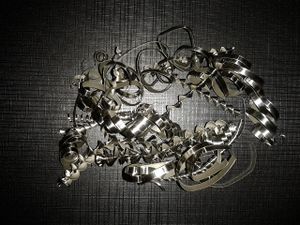Difference between revisions of "Titanium"
| Line 25: | Line 25: | ||
==Projects== | ==Projects== | ||
| − | |||
*Titanium salutes, sparklers, and other pyrotechnics | *Titanium salutes, sparklers, and other pyrotechnics | ||
*Thermite boosed with [[calcium sulfate]] | *Thermite boosed with [[calcium sulfate]] | ||
| Line 46: | Line 45: | ||
<references/> | <references/> | ||
===Relevant Sciencemadness threads=== | ===Relevant Sciencemadness threads=== | ||
| + | *[http://www.sciencemadness.org/talk/viewthread.php?tid=12422 titanium chemistry] | ||
[[Category:Elements]] | [[Category:Elements]] | ||
Revision as of 19:15, 23 December 2015
Titanium is a transition metal with the symbol Ti and the atomic number 22. It is a grayish, light metal that has high corrosion resistance, but can be converted to multiple oxidation states, most commonly +4 and +3.
Contents
Properties
Physical properties
Titanium is a gray metal of low density, only 60% more than that of aluminium, but is twice as strong. It is a common refractory material, and prized for its mechanical properties. It is slightly paramagnetic and exists in three allotropes. Its electrical conductivity is relatively poor for a metal.
Chemical properties
Although titanium does not appear to be reactive, as it does not corrode and generally resists attack by concentrated acids or bases, it has a very strong affinity to oxygen. Its reactivity is masked by the formation of a passivating oxide layer of titanium dioxide on the surface. Titanium will ignite at temperatures exceeding 1,200 °C to form the oxide and nitride in air. Therefore, melting titanium must be done in an inert atmosphere. The flame is white, but slightly yellowish compared to a magnesium flame.
Titanium(IV) is the most common oxidation state of the element. Compounds of titanium(IV) are extremely difficult to dissolve in aqueous solution as the TiO2+ (titanyl) ion only exists in highly acidic conditions. However, it can be produced very easily. The most common titanium(IV) compound is the oxide. Titanium(IV) chloride is a powerful Lewis acid that hydrolyzes to hydrogen chloride and titanium dioxide in the presence of water. Titanium(IV) also forms stable peroxo complexes, which are quite colorful.
Titanium(III) compounds are also accessible to the amateur. When added to hot concentrated hydrochloric acid, titanium dissolves to form titanium(III) chloride, which exists as a purple solution. Most titanium(III) compounds are bluish-purple due to the lone d electron, however, this purple color is not very strong due to the low probability of the transition. This is a good starting point for the production of many titanium compounds, such as titanium(III) oxide. Mixed titanium(III,IV) fluoro complexes can be produced, though they have not been studied well.
Titanium(II) compounds also exist, but these are very difficult to produce, as they reduce many materials, including water.
Preparation
Titanium can be prepared by reducing titanium tetrachloride with magnesium, though this reaction is difficult for the amateur chemist as both titanium and its chloride are sensitive to water and air. Industrially, this reaction is performed in vacuum.
An easier route to preparing titanium metal is through a thermite reaction between titanium dioxide and aluminium. The reaction doesn't proceed smoothly on its own, however, and instead must be boosted with a side reaction between aluminium and calcium sulfate, or some other booster. If large nodules of the metal are desired, about one part calcium fluoride per every two parts titanium dioxide can be used to help the mixture melt together.
Availability
Titanium is available in over 50 grades. Grades 1 through 4 are pure titanium, with the largest impurity being oxygen atom replacements in the crystal lattice. The other grades are titanium alloys.
Projects
- Titanium salutes, sparklers, and other pyrotechnics
- Thermite boosed with calcium sulfate
- Titanium tetrachloride synthesis
- Titanium electrodes
- Titanium halogen salts
- Anodizing titanium metal produces a wide range of colors:
Handling
Safety
Titanium powder and turnings can be flammable. Finely dispersed titanium dust can ignite spontaneously with electrical sparks or open flames, causing a flashover. Bulk titanium, however, is extremely difficult to ignite.
Storage
No special storage is required for titanium. Powdereded titanium however should be stored in a low oxygen container.
Disposal
Titanium and titanium compounds are non-toxic and do not require special disposal.

